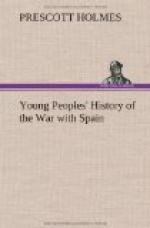[Illustration: King Alfonso.]
Cuba is the largest and most valuable of the West India Islands. It was discovered by Columbus about two weeks after his first landing at San Salvador. According to his custom, he gave it a Spanish name, but somehow the old name clung to it, and to-day the whole world knows the island by its native Indian name, Cuba. On account of its position, it is often called the “Key to the Gulf of Mexico;” and Havana, the capital, has a key upon its coat of arms. Cuba looks very small upon our maps, yet it contains nearly as much land as the State of Pennsylvania.
[Illustration: Queen Regent of Spain.]
Perhaps I should tell you just here that Spain is a kingdom. Its ruler, King Alfonso XII., died in 1885. His widow, Queen Christina, has ruled since then, but her son will be crowned king as soon as he is old enough. The “little king,” as he is often called, was twelve years old when this war began. Christina is a good and noble woman, and it is not her fault that the people in distant islands have been badly treated.
CHAPTER II.
The “Maine.”
Before the United States joined in the war, the Cubans had succeeded in driving the Spaniards out of many places in the eastern part of the island, but could not get possession of the western part and the chief harbors. We have seen that the war between the United States and Spain began in April, 1898. But, two months before that time something happened in the harbor of Havana, the capital of Cuba, which caused terrible excitement in our country. You must understand that many persons belonging to the United States have business in Cuba, own property there, and even live there. Though these Americans did not take part with the Cubans against Spain, yet it seemed sometimes as if they were in danger on account of the disturbance in the island. So our country decided to send one of our battleships—a man-of-war—to stay awhile in the chief harbor of Cuba, so that the Americans might feel safer by having such a ship to help them if they should need help, as I have told you. Spain made no objections to this plan, and said she would send a ship in return to visit New York. The ship chosen from our navy was the Maine, commanded by Captain Sigsbee. On January 25th, early in the morning of a bright warm day, the Maine, with all her colors flying, and with all her men dressed in their best clothes, drew near the harbor of Havana. A Spanish pilot went out to meet her, took her carefully through the narrow entrance to the fine harbor, and anchored her near some other ships. Though the entrance is narrow, yet the harbor itself is large enough to accommodate a thousand ships. The entrance is guarded by several fortresses, one of which, called “Morro Castle,” is nearly three hundred years old. It stands on a high point of land, and for this reason is called “Morro,” a name that means in Spanish, headland, or promontory.




